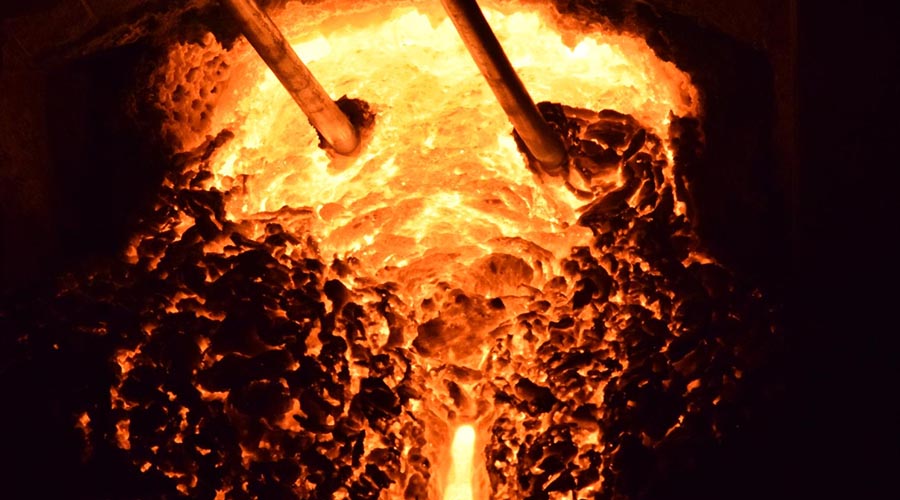In recent years, with the acceleration of railway rolling stock, there are higher requirements for the quality, variety, and performance of steel castings on locomotives. Especially for the steel castings at the running part, in addition to strengthening the design structure, new requirements are put forward for the internal quality and durability of steel castings. For example, the [O] content and inclusions in steel are strictly specified in the technical conditions of the coupler, bolster, and side frame. A feasible way to improve the internal quality and durability of steel castings is to use liquid steel refining technology to remove the [0], [n] gas content, and various harmful inclusions in liquid steel through the liquid steel refining process, so as to improve the internal quality of steel castings.
As we all know, there are two main sources of inclusions affecting the purity of cast steel. One is steel slag, molding sand, and refractory, which are foreign inclusions; The second is that about 80% of the inclusions in steel come from the chemical reaction products of the oxidation process and deoxidizer in liquid steel. According to statistics, 20% of the direct cost of steel castings is consumed in cleaning defects related to oxide inclusions. Controlling the number, size, and chemical composition of inclusions is an important way to obtain pure steel castings.
At present, the refining processes of pure cast steel mainly include hydrogen purification, calcium injection purification, AOD refining process, VOD Refining Process, LF ladle refining process, etc. At present, the domestic steel casting industry mainly adopts wire feeding and hydrogen blowing refining outside the furnace, Al CA line injection, AOD, VOD, and LF refining processes. These processes are more suitable for the refining production of small and medium-sized electric furnaces in casting production.
Considering the requirements of steel [O] content and impurities in the production environment and technical conditions of the steel casting plant, it is decided to adopt the wire feeding and hydrogen blowing refining process outside the furnace to meet the requirements of technical conditions of the coupler, bolster and side frame.
Basic Principle and Advantages of Liquid Steel Refining Process by Wire Feeding and Ammonia Blowing outside Furnace:
Liquid steel refining by wire feeding and ammonia blowing outside the furnace is a kind of liquid steel refining process outside the furnace. After tapping, aluminum wire or Si Ca Ba cored wire is fed into the liquid steel ladle with permeable brick for deoxidation, and hydrogen is blown into the liquid steel through ceramic permeable brick to purify the liquid steel. Since the permeable brick is installed at the bottom of the ladle, blowing hydrogen stirs the molten steel and forms small and dispersed hydrogen bubbles. These bubbles are equivalent to a vacuum chamber for H, O, and N in the liquid steel, They can be taken away to achieve the purpose of degassing.
Therefore, the principle of ladle hydrogen degassing is the same as that of vacuum degassing. For example, from the perspective of kinetic conditions, the effect may be more effective. At the same time, the floating of hydrogen bubbles causes the stirring of liquid steel, which can make the scattered small inclusions in liquid steel collide and gather to form low melting point large particle inclusions, which are adsorbed on the surface of bubbles and discharged, so as to improve the floating speed of inclusions and achieve the purpose of purification.
The main advantages of refining molten steel by wire feeding and hydrogen blowing outside the furnace are that the alloy elements and deoxidation products are evenly distributed, the segregation is reduced, the effect of removing gas and inclusions is better, the temperature is uniform, and the phenomenon of ladle bottom binding is reduced. Some applications show that [0] can be reduced from 1.2% 1.4×10-2% to 0.3% – 0.5×10-2% by hydrogen purification when melting carbon steel and low alloy steel in 10t electric arc furnace. Due to the purification of molten steel and uniform temperature, 10t molten steel can be poured into 20-30 boxes of castings (lasting for 40 min), and the ladle has no bottom. At the same time, this method can reduce and control the content of A1 in steel and improve the yield (generally, the yield of Al is 50% – 80%).
Based on Years of Research, It Is Concluded That:
1) The development and application of the refining technology of molten steel with wire feeding and hydrogen blowing outside the furnace has improved the quality of steel castings of couplers and met the loading needs of 70t vehicles.
2) The deoxidation technology of feeding aluminum wire can be used to control the aluminum content in the steel, improve the yield and reduce the amount of aluminum. Compared with conventional aluminum punching deoxidation, molten steel can save 0.9 kg of aluminum and has better economic benefits.
3) The successful development of this technology provides technical support and reserves for the future production of cast steel bolster and side frames, as well as the production of high-power diesel locomotive steel castings with high-quality requirements.

